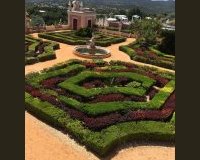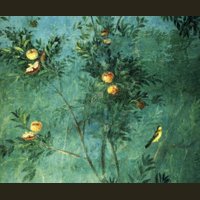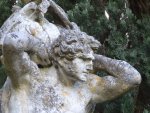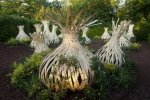accueil site > 10. Erasmus+ Mobility > 01. Erasmus + Key 1 Courses > New Erasmus + Mobility K1 courses 2016-2017, Pedagogy of landscape and (...)
New Erasmus + Mobility K1 courses 2016-2017, Pedagogy of landscape and gardenMonday 14 December 2015
Cultivate our garden, with Voltaire sense to educate, develop, make grow, which contains the germ of European humanity . Belong to Europe, as to the same garden
A.Rutily
The European Association Paysage et patrimoine sans frontière organises 3 new international training courses Erasmus+.
These courses are the result of the European project of training of trainers Socrates Comenius The garden, a living monument. Heritage education gardens in Europe, coordinated by Aline Rutily from 1999-2003 (approximately 40 courses European Comenius-Grundtvig since that date).
These courses are the result of several European projects coordinated by Aline Rutily, PhD in Science of Arts, Sorbonne University and visual artist, with the collaboration of universities of Padua, Granada, Louvain, of artistic centres and cultural associations in Bacau, Faro, Granada, Namur, Ravenna, San Quirico d’orcia, Montecchio, Funchal, Trieste, of schools in Bacau, Cortina d’Ampezzo…
![]() Trainers training multilateral project Comenius Le jardin, monument vivant. Pédagogie du patrimoine des jardins en Europe and their Accompanying Measures in 2008 : approximately 40 European Comenius-Grundtvig courses, for more than 600 teachers and trainers,
Trainers training multilateral project Comenius Le jardin, monument vivant. Pédagogie du patrimoine des jardins en Europe and their Accompanying Measures in 2008 : approximately 40 European Comenius-Grundtvig courses, for more than 600 teachers and trainers,
![]() Grundvig Workshop Articuler le végétal aux arts du livre, Versailles, 2009,
Grundvig Workshop Articuler le végétal aux arts du livre, Versailles, 2009,
![]() Grundtvig partnership Breaking the barriers. Improve access to long life learning 2009-2011
Grundtvig partnership Breaking the barriers. Improve access to long life learning 2009-2011
![]() Grundtvig partnership Langages du végétal en Europe 2012-2014,
Grundtvig partnership Langages du végétal en Europe 2012-2014,
![]() Study visit Pédagogie de l’histoire de l’art en Europe, Paris, 2012
Study visit Pédagogie de l’histoire de l’art en Europe, Paris, 2012
![]() Our Star project Leonardo da Vinci Echanges de pratiques sur les métiers du paysage, 2010-2012
Our Star project Leonardo da Vinci Echanges de pratiques sur les métiers du paysage, 2010-2012
Objectives
![]() Contribute to the teachers training in the field of garden and landscape art history, from common themes
Contribute to the teachers training in the field of garden and landscape art history, from common themes
![]() Build a common European culture, through access to knowledge and mutual respect of cultures, while preserving their diversity and identity.
Build a common European culture, through access to knowledge and mutual respect of cultures, while preserving their diversity and identity.
![]() Identify tools and practical training approaches, to facilitate the implementation of education of European garden and landscape art history.
Identify tools and practical training approaches, to facilitate the implementation of education of European garden and landscape art history.
Methodology
The various devices are based on common concepts:
![]() transversality of learning at the crossroads of science, literature, poetry and visual arts,
transversality of learning at the crossroads of science, literature, poetry and visual arts,
![]() Solicitation of imagination, creativity,
Solicitation of imagination, creativity,
![]() Articulation of the languages,
Articulation of the languages,
![]() Integration of new technologies of communication,
Integration of new technologies of communication,
![]() Updating knowledge of the European history of the gardens, its development in different places in Europe.
Updating knowledge of the European history of the gardens, its development in different places in Europe.
The methodology has a strong focus on a transversal approach, by:
![]() different readings of the garden, in situ (science, geography, literature, landscape, history, photography, visual arts)
different readings of the garden, in situ (science, geography, literature, landscape, history, photography, visual arts)
![]() learning tools online (website made by the trainers), in particular the participation by each one of virtual garden note-books or herbarium,
learning tools online (website made by the trainers), in particular the participation by each one of virtual garden note-books or herbarium,
![]() the articulation in this note-book of different languages : verbal, visual, literary, scientific,
the articulation in this note-book of different languages : verbal, visual, literary, scientific,
![]() the creative use of the information and communication technology,
the creative use of the information and communication technology,
![]() a common base in intercultural education for citizenship and European values, through the common theme of the garden and its history,
a common base in intercultural education for citizenship and European values, through the common theme of the garden and its history,
![]() the development of European partnerships in the field of education in garden art history and in cross-disciplinary motivating approaches.
the development of European partnerships in the field of education in garden art history and in cross-disciplinary motivating approaches.
Monitoring training
![]() Development of educational projects during the course,
Development of educational projects during the course,
![]() Monitoring these projects,
Monitoring these projects,
![]() Using different collaborative tools (website, forum, note-books…).
Using different collaborative tools (website, forum, note-books…).
Contact: aline.rutily@paysage-patrimoine.eu
1 Teaching the history of art of landscape and garden, through literature, art and science.
April 18-23, 2016 and April 10-15, 2015, Venice-Padua, Italy
The Botanical Garden of the University of Padua is famous for its illustrious teachers such as Copernicus and Galileo; it is the oldest in Europe (1545). This historic Garden preserves over 6,000 species of rare and old plants, ginkgo, magnolia, and especially a palm tree planted in 1585 and already observed by Goethe, when his travels in Italy. From the point of view of art history, the city of Padua is a real museum, which illustrates the artworks of Giotto, Palladio, Lippi, Donatello, Canova… The course also takes place in Venice, through a botanical and gustative route, throw its gardens of yesterday and today.This course was born from the collaboration of the Association Paysage et patrimoine sans frontière with numerous partners in France, Italy, Romania. We build in this course approaches to learn art history of garden and landscape, through the articulation of language, literature, photography, multi- sensory approach.
2 The garden, a living monument. Heritage education and art history in Europa
This course was born from the collaboration of the Association Paysage et patrimoine sans frontière with National History Museum of Paris, gardens of Paris and Versailles in France, Madeira and education environmental centers. We explain in this course the modern european concept of the garden as a living monument, defined in Florence in 1982, in the founding text which is at the origin of our course.
February 22 -27, 2016 and February 13 -18, 2017, Funchal, Madeira, Portugal
The course takes place in the prestigious botanical garden overlooking the ocean and the tropical Monte Palace Park planted with orchids and giant tree ferns. The course focuses on art history and biodiversity of this " floating garden " born of a volcanic eruption. This is an invitation to travel, sometimes by cable-car, throw the Laurissilva, native and endemic forest of the island of Madeira, World Natural Heritage since 1999.
May 15-20, 2017, Paris, France _ The course was born in partnership with the Romanian Cultural Institute, the gardens and museums of Paris and Versailles. The course focuses on the links between arts and sciences, space, landscape and garden history from the Middle Ages to the present day.
April, 3 -8, 2017, Granada, Spain
Thanks to the partners of the association Paysage et patrimoine sans frontière in Granada, the course takes place successively in ancient carmens, botanical garden, Education Center for Adults, Schools of Fine Arts, in the districts of Albaicin and the Sacro Monte, birthplace of flamenco and, of course, in the Alhambra, a major monument of Arab architecture and one of the most celebrated through literature and poetry.
April, 18 -23, 2017, Parma, Montecchio, Italy
Thanks to the partners of the association Paysage et patrimoine sans frontière in Parma and especially the Popular University of Montecchio, the course takes place successively in parks, museums, gardens, and in the International photography exhibition to be held at the time of the course ; the course focuses on individual garden books, through the concept of virtual notebook on line, between arts and sciences, literature and poetry.
3 Teaching landscape creation in Europe, through experimentation in situ
July,3-8 July 2017, Chaumont-sur-Loire, Pays de Loire, France
This course was born from the collaboration of the Association Paysage et patrimoine sans frontier with the International Festival of Chaumont -sur- Loire, in the Loire Valley, famous for its French Renaissance castles. The course focuses on learning processes in the economic field of different business of the landscape. Participants will be encouraged to build their own models of landscape and gardens, suggested by the creations of the Festival Gardens and the readings of historic gardens of Villandry, Blois and La Bourdaisière, Tomato Conservatory, created by Louis Albert de Broglie, the Prince Jardinier.


















 Printable version
Printable version


